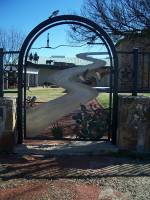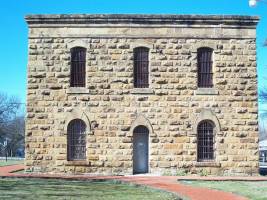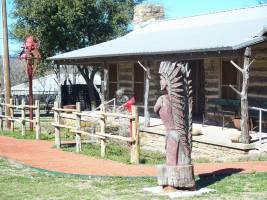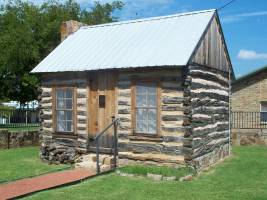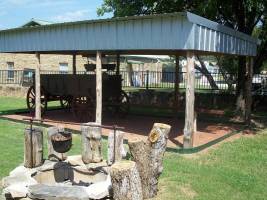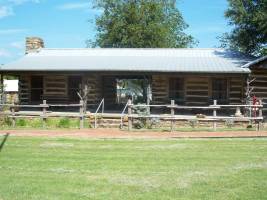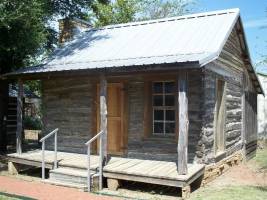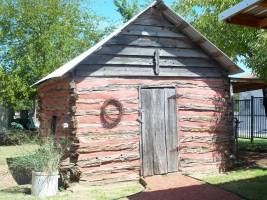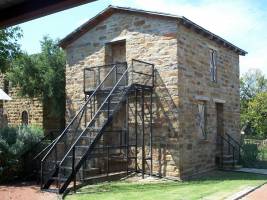Open Dates & Times
Open 1st weekend of March to 2nd weekend of December
Every Thursday thru Saturday
10:00 am to 3:00 pm
Location
5th & Elm
Palo Pinto, Texas
Click an image to enlarge
The Old Jail Museum Complex features many buildings, artifacts, and the fascinating history that go along with them.
The Old Jail
The first floor of the Jail was a residence for the jailer and his family; they lived between two heavy steel doors—one to the outside world, the other a pass-through door for serving meals to the prisoners.
Now the first floor houses artifacts and stories of the pioneers of Palo Pinto County. Explore the first floor artifacts and be sure to locate the framed pictures of the Sheriffs with “loaded” dice from a gambling machine destroyed by the Palo Pinto County Sheriffs Department, the 1856 Palo Pinto County Star Press, and the Switchboard used by the Palo Pinto Telephone Company.
The steep iron stairs to the second floor are topped by a hangman’s noose and trap door. This was added in 1906, but never used. Displayed here are arrow heads left by the earliest inhabitants.
The large room, with three sets of bars on the windows instead of the one downstairs, would have contained metal jail cells like the large one in the Yard. The cells were removed to provide exhibits that reflect the enormous influence of ranching in the county.
Numerous saddles, branding irons, and ranching gear are also displayed. Old washing machines, military uniforms, and musical instruments also exemplify the history of Palo Pinto. Old railroad lanterns, a telegraph, and the hoop to get the mail on the moving train are included in the railroad display. See the doctor’s examining room with its medicine bottles and medical instruments and equipment.
The jail was vacated in 1941 when the jail was moved to the top floor of new courthouse. The Palo Pinto Historical Association restored the building in 1968 to house the museum.
The Yard
As you tour the yard outside the Jail, you will see jail holding cells, hitching post and stile block, a well, log corn and wheat cribs, thresher, wagon, and other ranching and farming implements. The rock fence partly surrounding the complex was built by the Works Progress Administration 1935—1937.
The Dog Trot Moseley Cabin
Tour this original dogtrot cabin moved from the J R C Moseley Ranch in Magic Valley and reconstructed on this site in 1972.
Picture life in the kitchen and bedroom. Each room is filled with items used in daily ranch life. The kitchen fireplace has items necessary for meal preparation. The bedroom has a rope bed with a chamber pot under it. A doll sleeps in an cradle used for four generations. Notice the sewing machine operated by “foot power.” Can you imagine life without electricity?
A corner of the bedroom is dedicated to Allen Ramsey, a long time county historian who assisted in the reconstruction.
The Johnson Cabin
This two-room cabin was originally on the Rhodes Ranch and is another example of living quarters for the early pioneer settlers.
The front room examines the life of John Winters, long time Palo Pinto Tax Assessor and county historian. It is a tribute to the life of John Winters and his many accomplishments.
The back room depicts a pioneer bedroom. Admire the beautiful handcrafted sleigh bed. During this time period, everything was put to use - even flour sacks, the softest fabric available for hand-sewn underpants.
The Roe-Maddox Cabin
Visit the Blacksmith Shop, which originally served as a kitchen on the Maddox Ranch on Dodson Prairie and reconstructed on this site in l986. See the tools and equipment a blacksmith used daily.
Sam Bass, the famous outlaw, visited the Maddox Ranch while on the run from the posse. As was customary, strangers were provided food and shelter. Look for the full story on the cabin wall.
The Carriage House
See the restored Crossland Buggy. Just imagine “going to town” traveling in the buggy being pulled by a horse. The ride from Lone Camp to Palo Pinto would take 4 hours.
Barrows–Edgin Log Cabin
This one-room log cabin, an example of a typical home of the early settlers, was located on the west edge of Mineral Wells, on a hill overlooking the north side of the present day “West City Park.”
E. N. Barrows and his wife purchased the property in 1905. Their daughter, Grace, born in Palo Pinto County in 1879, married Jim Edgin, and the land passed to their daughter, Ethel Edgin, who retained ownership until she sold it to her cousin, W. C. Vincent in 1971. Robert Upham purchased the property in 2006, and donated the cabin to the Palo Pinto Historical Association. It was moved intact and restored at its present location in October 2007.
Fort Black Springs
The Black Springs Fort, originally located in Oran (formerly called Black Springs) near the intersection of the 1851-52 military roads between Fort Worth-Fort Belknap and Fort Graham-Fort Belknap. It is unclear who originally built the three story, sandstone structure and when. It’s possibly the oldest structure in Palo Pinto, the original beams were hand hewn and the nails, brittle wrought iron, to indicate construction prior to 1870.The original window beams are on display.
Oral histories tell us that the fort would be a stop over for either military road. Travelers and settlers used the fort during Indian scares. Similar to other military structures at the time, the horses were kept on the lower floor; officers and enlisted men on the second and third floor.
The structure was donated by F O Cooper, the landowner in 2000, and each rock numbered and moved to the Museum property. In 2007, Palo Pinto County’s Sesquicentennial year, the fort was reconstructed at its present location
Jean Price Welcome Center
Completed in 2006, the goal for the center is to serve as a source for genealogy research and special displays like the Painted Post from the Sesquicentennial Celebration. Also on display the military role in Palo Pinto. Cataloguing of the numerous documents is underway.

